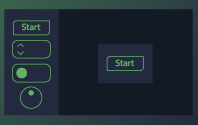Wireframing
| Plan your UI properly. Know what elements, such as screens, components, and states, you need. Create a descriptive wireframe and acquire a detailed UI specification before you start to make the process of creating the UI more efficient. Qt Design Studio enables you to turn your UI concept into a wireframe with a scalable layout where all your screens and controls are in place. You can present your wireframe to developers and other stakeholders for discussion, review, and approval before continuing into the prototyping phase. |
In Qt Design Studio, you build UIs around the behavior of components and how they connect with one another. You can use preset components available in the Components view or combine them to create your own components. You can specify values for the properties of a component to change its appearance and behavior. All components have a set of predefined properties, some of which control things that are visible to users, while others are used behind the scene.
You drag the preset components from the Components view to the 2D, 3D, or Navigator view to create instances of them. You then change the instances to your liking by modifying their properties in the Properties view. The application code is generated for you accordingly. For more information about the code, open the developer documentation by pressing F1.
- Using components
Qt Design Studio comes with preset components that you can use in wireframes and prototypes by creating instances of them. To build your own components, you can modify the properties of the component instances and combine them. You can import designs and assets from other tools as components.
- Specifying component properties
You can specify values for the properties of a component to change its appearance and behavior. All components have a set of predefined properties. Some properties, such as position, size, and visibility, are common to all components, whereas others are specific to the component. You can specify values for properties of component instances in the Properties view.
- Scalable layouts
The position of a component in a UI can be either absolute or relative to other components. While manual positioning is efficient for a static UI, consider the other available methods, such as anchors, layouts, positioners, and property bindings, for dynamic UIs.
- Annotating designs
You can annotate your designs to provide reviewers or developers with additional information about them.
Available under certain Qt licenses.
Find out more.


